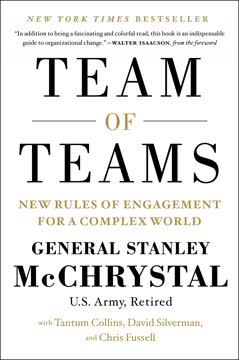Key Takeaways
1. Kanban Simplifies Project Management for Continuous Value Delivery
With Kanban, for the first time in my long career, I can honestly say that every minute of work my teams do adds value for customers to our products.
Streamlined Approach. Kanban offers a straightforward method for managing projects, emphasizing the continuous delivery of value to customers. Unlike traditional methodologies, Kanban minimizes time spent on non-value-added activities, such as excessive planning meetings and process discussions. This focus allows teams to concentrate their efforts on producing high-quality deliverables efficiently.
Focus on Value. By prioritizing customer value, Kanban ensures that every task undertaken directly contributes to the end product. This approach reduces waste and maximizes the impact of each team member's efforts. Kanban's simplicity and effectiveness make it an ideal choice for teams seeking to improve their productivity and deliver exceptional results.
Adaptability. Kanban's flexibility allows it to be implemented in various environments, from small startups to large organizations. Its principles can be tailored to fit the specific needs and constraints of any project, making it a versatile tool for project management. Kanban's emphasis on continuous improvement encourages teams to refine their processes and adapt to changing circumstances, ensuring long-term success.
2. Visualize Workflow to Enhance Team Coordination and Issue Resolution
Visualizing workflow is one of Kanban’s core principles.
Transparency and Awareness. A central tenet of Kanban is the visualization of the project workflow, typically through a physical or virtual signboard. This visual representation provides team members with a clear understanding of the project's progress, bottlenecks, and potential issues. By making the workflow transparent, Kanban fosters better communication and collaboration among team members.
Early Issue Detection. The signboard serves as a real-time indicator of project status, allowing team members to quickly identify and address any impediments. This proactive approach helps prevent problems from escalating and ensures that the project stays on track. The visual nature of the signboard also promotes a shared sense of ownership and accountability among team members.
Improved Coordination. By visualizing the workflow, Kanban facilitates better coordination and alignment within the team. Team members can easily see who is working on what, what tasks are blocked, and what needs to be done next. This shared understanding promotes a more collaborative and efficient work environment.
3. Limit Work in Progress (WIP) to Optimize Flow and Reduce Waste
In Kanban, chaos is limited by directly limiting the amount of work in progress (WIP)—literally, the number of note cards allowed at each step.
Controlled Chaos. Kanban directly addresses the chaos inherent in group work by limiting the amount of work in progress (WIP) at each stage of the workflow. This constraint prevents team members from becoming overwhelmed and ensures that tasks are completed efficiently. By limiting WIP, Kanban promotes a smoother, more focused work environment.
Reduced Context Switching. Limiting WIP reduces the amount of multitasking and context switching that team members must perform. This focus allows individuals to concentrate their efforts on completing tasks, leading to higher quality work and faster turnaround times. Kanban's emphasis on limiting WIP helps teams avoid the pitfalls of trying to do too much at once.
Bottleneck Management. WIP limits help identify bottlenecks in the workflow, allowing teams to address them proactively. By focusing on the slowest step in the process, teams can optimize their overall throughput and deliver value to customers more quickly. Kanban's WIP limits serve as a powerful tool for continuous improvement.
4. Define "Done" Criteria to Drive Quality Upstream
Before a note card is moved from the left to the right column of a step, the work on that item must pass certain rules—your definition of “done” for that step (also known as the pull criteria).
Quality Assurance. Kanban emphasizes the importance of defining clear "done" criteria for each step in the workflow. These criteria serve as quality gates, ensuring that tasks meet specific standards before progressing to the next stage. By defining "done" criteria, Kanban promotes a culture of quality and accountability within the team.
Upstream Quality. The "done" criteria drive quality upstream, preventing defects from propagating through the workflow. By catching errors early, teams can reduce rework and deliver higher quality products to customers. Kanban's emphasis on "done" criteria helps teams avoid the costly consequences of discovering defects late in the development process.
Clear Expectations. Defining "done" criteria provides team members with clear expectations for each task. This clarity reduces ambiguity and ensures that everyone is working towards the same goals. Kanban's emphasis on "done" criteria promotes a more efficient and effective work environment.
5. Adapt Kanban to Existing Methodologies for Seamless Integration
This book also has chapters especially for people who want to adapt from traditional Waterfall methods or evolve from Scrum.
Flexibility. Kanban is designed to be adaptable and can be seamlessly integrated into existing project management methodologies, such as Waterfall and Scrum. This flexibility allows teams to adopt Kanban without disrupting their current workflows. By adapting Kanban to their specific needs, teams can leverage its benefits while maintaining their familiar processes.
Evolution, Not Revolution. Kanban is often presented as an evolution rather than a revolution, making it easier for teams to embrace the change. By gradually incorporating Kanban principles, teams can avoid the resistance and disruption that often accompany radical changes. Kanban's emphasis on continuous improvement allows teams to evolve their processes over time, ensuring a smooth and sustainable transition.
Bridging Methodologies. Kanban can serve as a bridge between different methodologies, allowing teams to collaborate more effectively. By providing a common framework for visualizing and managing work, Kanban can help teams overcome the communication barriers that often arise when using different approaches. Kanban's adaptability makes it a valuable tool for organizations seeking to improve collaboration and efficiency across diverse teams.
6. Measure and Celebrate Performance Improvements to Reinforce Kanban Adoption
Change only succeeds if managers say, “Yes, you should do this,” and later reward employees who do it.
Quantifiable Results. To ensure the successful adoption of Kanban, it is essential to measure and celebrate performance improvements. By tracking key metrics, such as throughput and cycle time, teams can demonstrate the value of Kanban to stakeholders. Celebrating these improvements reinforces positive behaviors and encourages continued adoption.
Data-Driven Decision Making. Measuring performance provides teams with valuable data for making informed decisions about their processes. By analyzing metrics, teams can identify areas for improvement and refine their Kanban implementation. Kanban's emphasis on measurement promotes a data-driven approach to project management.
Team Morale. Celebrating performance improvements boosts team morale and fosters a sense of accomplishment. By recognizing and rewarding team members for their contributions, organizations can create a more positive and productive work environment. Kanban's emphasis on celebration reinforces the value of continuous improvement and encourages teams to strive for excellence.
7. Scale Kanban Across Organizations for Enhanced Project Coordination
This chapter is for people currently using a traditional Waterfall method for product development.
Coordination at Scale. Kanban can be scaled across large organizations to enhance project coordination and alignment. By providing a common framework for visualizing and managing work, Kanban can help teams collaborate more effectively on complex projects. Scaling Kanban requires careful planning and communication, but the benefits can be significant.
Dependency Management. In large organizations, managing dependencies between teams is crucial for project success. Kanban facilitates dependency management by making dependencies visible and allowing teams to coordinate their work more effectively. By identifying and addressing dependencies early, teams can avoid delays and ensure that projects stay on track.
Transparency and Accountability. Scaling Kanban across an organization promotes transparency and accountability. By making project status visible to all stakeholders, Kanban ensures that everyone is aware of progress and potential issues. This transparency fosters a culture of accountability and encourages teams to take ownership of their work.
8. Address Dependencies Proactively to Maintain Project Momentum
You can handle late dependencies effectively with Kanban in several ways.
Dependency Visibility. Kanban helps teams identify and address dependencies proactively, minimizing the impact of delays and disruptions. By visualizing dependencies on the signboard, teams can anticipate potential problems and take steps to mitigate them. Kanban's emphasis on dependency management helps teams maintain project momentum and deliver value to customers on time.
Mitigation Strategies. When dependencies are late or unstable, Kanban provides teams with a range of mitigation strategies. These strategies include creating fake implementations, writing shims, and assisting upstream partner teams. By proactively addressing dependencies, teams can minimize the impact of external factors on their work.
Collaboration and Communication. Effective dependency management requires strong collaboration and communication between teams. Kanban fosters this collaboration by providing a common framework for visualizing and managing work. By working together to address dependencies, teams can ensure that projects stay on track and deliver value to customers.
9. Sustained Engineering with Kanban Ensures Continuous Product Improvement
Most teams that release a product or service to customers perform software maintenance after release.
Post-Release Support. Kanban is well-suited for sustained engineering (SE), which involves maintaining and improving products after their initial release. By providing a structured approach to managing bug fixes and enhancements, Kanban ensures that products continue to meet customer needs. Kanban's emphasis on continuous improvement makes it an ideal choice for SE teams.
Prioritization and Efficiency. Kanban helps SE teams prioritize their work and allocate resources efficiently. By visualizing the backlog and limiting work in progress, teams can focus on the most important issues and deliver timely solutions. Kanban's emphasis on efficiency ensures that SE teams can maximize their impact.
Collaboration and Communication. Effective SE requires strong collaboration and communication between the core engineering team and customer support. Kanban facilitates this collaboration by providing a common framework for visualizing and managing work. By working together to address customer issues, teams can ensure that products continue to meet customer needs.
10. Embrace Continuous Improvement to Maximize Kanban's Potential
I’m always looking for advantages over my competition—ways that make my life easier and more productive while also resulting in better products for my customers.
Kaizen Mindset. Kanban is not a static methodology but rather a framework for continuous improvement. By embracing a kaizen mindset, teams can constantly refine their processes and optimize their performance. Kanban's emphasis on continuous improvement ensures that teams are always striving to deliver greater value to customers.
Experimentation and Adaptation. To maximize the potential of Kanban, teams should experiment with different practices and adapt their approach to fit their specific needs. By trying new things and learning from their experiences, teams can continuously improve their Kanban implementation. Kanban's flexibility allows teams to tailor their processes to achieve optimal results.
Long-Term Success. By embracing continuous improvement, teams can ensure the long-term success of their Kanban implementation. Kanban is not a one-size-fits-all solution but rather a framework for ongoing learning and adaptation. By continuously refining their processes, teams can deliver greater value to customers and achieve their business goals.
Last updated:
FAQ
What's "Agile Project Management with Kanban" by Eric Brechner about?
- Overview of Kanban: The book provides a comprehensive guide to using Kanban for managing software projects with efficiency, predictability, and simplicity.
- Focus on Practical Application: It emphasizes practical, step-by-step instructions for implementing Kanban in real-world scenarios, particularly in software development.
- Adaptation and Evolution: The book discusses how teams can adapt from traditional Waterfall methods or evolve from Scrum to Kanban.
- Continuous Improvement: It highlights the importance of continuous delivery and customer feedback in improving product quality and team productivity.
Why should I read "Agile Project Management with Kanban"?
- Proven Methodology: Kanban is a proven method for managing complex projects, and the book offers insights from Eric Brechner's extensive experience at Microsoft.
- Practical Guidance: It provides actionable steps and checklists that can be directly applied to improve project management practices.
- Adaptability: The book is suitable for teams of all sizes and can be adapted to various project management styles, including Waterfall and Scrum.
- Enhanced Productivity: By reading this book, you can learn how to deliver high-quality software on time and within budget, while also improving team morale and customer satisfaction.
What are the key takeaways of "Agile Project Management with Kanban"?
- Visualization and Flow: Kanban emphasizes visualizing work and managing flow to improve efficiency and reduce bottlenecks.
- Work-in-Progress Limits: Setting limits on work-in-progress (WIP) is crucial for maintaining a smooth workflow and preventing overload.
- Continuous Delivery: The book advocates for continuous integration and deployment to ensure that software is always in a releasable state.
- Customer Feedback: Regular customer feedback is essential for refining products and ensuring they meet user needs.
How does Eric Brechner suggest implementing Kanban in a team?
- Start with a Signboard: Create a physical or virtual signboard to visualize the workflow and track progress.
- Define Workflow Steps: Clearly define the steps in your workflow, such as Specify, Implement, and Validate, and set WIP limits for each.
- Daily Standups: Conduct daily standup meetings to address any blocking issues and ensure smooth progress.
- Adjust and Improve: Continuously adjust WIP limits and workflow steps based on team feedback and performance metrics.
What are the benefits of using Kanban according to "Agile Project Management with Kanban"?
- Increased Efficiency: Kanban helps teams work more efficiently by visualizing work and limiting WIP.
- Improved Quality: By enforcing done rules and focusing on continuous delivery, Kanban ensures high-quality outputs.
- Flexibility: Kanban is adaptable to various team sizes and project types, making it a versatile project management tool.
- Enhanced Collaboration: The method encourages collaboration and communication among team members, leading to better problem-solving and innovation.
How does "Agile Project Management with Kanban" address transitioning from Waterfall to Kanban?
- Smooth Transition: The book provides guidance on how to transition smoothly from Waterfall to Kanban without disrupting existing workflows.
- Small Batches: It emphasizes the importance of working in small batches to improve flexibility and responsiveness to change.
- Focus on Quality: Kanban's focus on quality and continuous improvement helps teams overcome the limitations of Waterfall's rigid structure.
- Customer Engagement: The transition involves increasing customer engagement to ensure that products meet user needs and expectations.
How does "Agile Project Management with Kanban" suggest evolving from Scrum to Kanban?
- Continuous Flow: Kanban removes the artificial boundaries of sprints, allowing for a continuous flow of work and feedback.
- Simplified Roles: The book suggests simplifying roles and responsibilities, allowing teams to focus more on delivering value.
- Reduced Overhead: By eliminating some of Scrum's events, Kanban reduces overhead and allows teams to focus on delivering high-quality products.
- Enhanced Agility: Kanban enhances agility by enabling teams to respond to changes and customer feedback more quickly.
What are the best quotes from "Agile Project Management with Kanban" and what do they mean?
- "Every minute of work my teams do adds value for customers to our products." This quote emphasizes the efficiency and customer-centric focus of Kanban.
- "Kanban helps you deliver value to your customers faster than Waterfall, Scrum, or just about any other project-management method." It highlights Kanban's effectiveness in improving delivery speed and quality.
- "The only meetings Kanban typically has are daily standup meetings at the team signboard." This underscores Kanban's simplicity and focus on essential communication.
- "Kanban distinguishes between finishing one step and starting the next." It points to the importance of clear workflow stages and quality checks in Kanban.
How does "Agile Project Management with Kanban" address dealing with dependencies?
- Track Dependencies: The book suggests using a Track column on the signboard to manage dependencies and ensure they don't block progress.
- Create Fakes or Shims: For late or unstable dependencies, create temporary solutions to keep work moving forward.
- Collaborate with Partners: Work closely with partner teams to address dependencies and ensure timely delivery.
- Prioritize Critical Dependencies: Focus on resolving critical dependencies that impact the project's critical chain.
What is the role of customer feedback in "Agile Project Management with Kanban"?
- Continuous Improvement: Customer feedback is integral to Kanban's continuous improvement process, helping teams refine products and processes.
- Engagement Opportunities: The book encourages frequent customer engagement to gather insights and validate product features.
- Feedback Loops: Establishing feedback loops ensures that customer needs are met and that products remain relevant and valuable.
- Iterative Development: Feedback is used to guide iterative development, allowing teams to make informed decisions and prioritize work effectively.
How does "Agile Project Management with Kanban" suggest handling sustained engineering?
- Define Roles and Responsibilities: Clearly define the roles of customer support, product management, and the core engineering team in handling post-release issues.
- Implement a Kanban Workflow: Use a Kanban board to track escalations and bugs, ensuring that the most critical issues are addressed first.
- Triage and Quick-Solve Meetings: Conduct regular triage and quick-solve meetings to prioritize issues and resolve them efficiently.
- Continuous Improvement: Use root-cause analysis to identify and address the underlying causes of defects, improving product quality over time.
What are the theoretical foundations of Kanban according to Eric Brechner?
- Little’s Law: The book explains how Little’s Law relates WIP, throughput, and response time, emphasizing the importance of limiting WIP.
- Theory of Constraints: It discusses the theory of constraints and how identifying and addressing bottlenecks can improve workflow efficiency.
- Drum-Buffer-Rope: The drum-buffer-rope concept is used to balance workflow and ensure that the pace of work matches the system's capacity.
- Single-Piece Flow: The book advocates for single-piece flow to minimize WIP and maximize responsiveness to customer needs.
Review Summary
Agile Project Management with Kanban receives generally positive reviews, praised for its concise, practical approach to implementing Kanban in software development. Readers appreciate its real-world examples, clear explanations, and focus on visual workflow management. Some find it an excellent introduction, while others note it lacks depth for more advanced users. The book's brevity is both a strength and weakness, making it accessible but potentially leaving some readers wanting more. Overall, it's considered a valuable resource for teams transitioning to or improving their Kanban practices.
Similar Books










Download PDF
Download EPUB
.epub digital book format is ideal for reading ebooks on phones, tablets, and e-readers.




